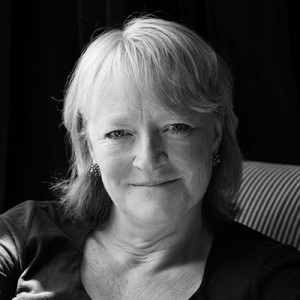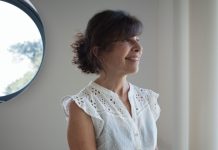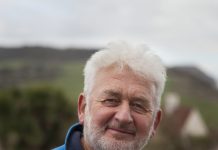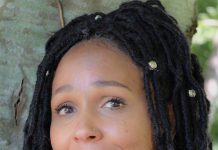Robin Mills went to Bridport to meet Alex Coulter. This is her story.
“My father was a tropical agricultural scientist, a soil scientist, and his job was in Trinidad at the time I was born. He came from a farming family in Northern Ireland, the oldest of 8, and was the one who was educated and travelled for his work. All his life his work involved travel, so he was a bit of an absent father, but when I was born he was teaching at the university in Trinidad. We came back to England when I was four and lived in Hertfordshire, where we stayed until I was 16, living what you could call a fairly classic English childhood. My mother was a very full-time Mum, with 5 of us children and my father away most of the time. We had holidays in Swanage, which is where she came from; we had a little cottage there.
When I was 16, my father got a job in Washington DC, so they moved there. I had to go to boarding school for my A levels, and my youngest brother went to school in America so we were rather split up as a family. That seemed a bit unsettling at the time, but in a way it was quite an interesting thing to happen to us, broadening our horizons. My family stayed out there for the next 15 years, but I continued my education in England although I’d visit Washington for holidays. I became more and more interested in the arts as I grew up, doing A-levels in Art, and History of Art; then I went to the Courtauld Institute, part of London University, to study History of Art. That was a significant time for me. For a start, I met my future husband on the first day, at a drinks party in the Director’s office. He walked in the door, and that was kind of “it”, although we didn’t really get together till the end of the course.
I didn’t enjoy studying at the Courtauld all that much. I found it very dry and academic. It’s a small college, quite traditional at that time in its approach to Art History, and I specialised in the 15th Century. I wasn’t terribly happy there, although obviously I met my husband Gijs and made lots of friends. So when I left, I went to Art School, which was probably what I’d always wanted to do. I did painting at Chelsea, and became quite focussed on becoming an artist. Gijs was working in a gallery in Cork Street, and it was a very sociable time for us, as London generally is for people of that age at that stage in their lives. But after a while, London began to feel a bit limiting, both of us coming from families that had travelled a lot. So we had the idea we wanted to go to Spain, packed our little green 2CV and off we went.
Gijs’s plan was that he’d write a book about Spanish food. We went to several different places trying to find somewhere to live, and ended up in Segovia, right in the heart of Spain. We found a lovely old flat in a part of the city, full of character, where there were little bars, and funny shops—Calle de la Muerte y Vida (Death and Life Street). I taught a bit of English and was painting, and Gijs worked in a restaurant learning how to cook and writing about it. We made lots of Spanish friends who remain the core of a group of friends we still have.
We explored the countryside outside Segovia, and one day in a tiny village called Arevalillo de Cega, about 40km from the city, we spotted a house with an old hand-written sign saying “Se vende”. Perhaps a bit impulsively, we decided we’d try and buy it. I was pregnant with our first child, Driky, at that time, but we moved in and lived there for two years. In the winter the population of the village was about 8; the shepherd and his wife, the farmer and his wife, and about 3 old people. All of whom, including our Spanish friends, thought we were mad to want to live there, especially in winter. Although the house was only semi-habitable, it was an amazing place to live, in the foothills between the mountains and the plain, wild and remote, with vultures and wild boar. But we were very young and on an adventure, so I don’t think we really thought through the implications of living in a place like that. We stayed, and our second child, Rosa, was born, but there wasn’t really an obvious way of making our futures there, so we decided we had to come back to England. Although interestingly, Gijs’s writing is all about Spain, it’s at the centre of his work. And for us as a family, the village is still a really important part of our lives, where we go back every summer. The houses in the village are still owned by the same families—the younger generations all left in the sixties and seventies to find work—but in the summer, they all come back, and the village fills up to a population of about 200. There’s an amazing week-long fiesta, and because our children have been going back every year they’re completely integrated in the community; there’s no way we’d ever miss it.
Coming back to England, we visited an old friend of Gijs’s who lived in Dorset, and we liked it, so we rented a cottage on the Mapperton Estate and I taught at Yeovil College. Then we moved to Bridport in ’94. It almost goes without saying that it is a vibrant place to live, and we’ve been very happy here—it’s been a great place to bring up the children, who have all done really well at local schools and love it here as well. I got very involved with the Arts Centre, and began teaching at Weymouth College. Then I got the job at Dorset County Hospital as Arts Coordinator, 15 years ago now, and for a while carried on teaching as it was only 3 days a week. I was still making my own work at the time, but once I’d started the hospital job I decided to stop. It didn’t seem to fit, being less involved with the hands-on side of art as I was when teaching, and I was now spending more time commissioning artists, developing project ideas, fundraising, and that kind of thing. I found it fascinating working in a health environment, bringing art into that very different culture. It’s been stimulating and interesting, and it was the start of what’s become my career. I left teaching after a few years, and started doing freelance work for other hospitals, and working in public health arts projects. Eventually I got the job of Director of Arts and Health South West, which is what I’m now doing, and I left the hospital last April after 15 years. That was a slight relief as I was so busy, but it was quite a big part of my life, which involved a considerable learning curve, and was hugely rewarding work. Over the years, it’s interesting how Art in Hospitals has become quite embedded. Health professionals have varying views about it, but most of the staff in the hospital are really enthusiastic, and understand the benefits for all concerned, patients, staff and visitors. The health world likes to see evidence that art brings a benefit, in the same way that they assess everything; while everyone in the arts assumes it’s obviously a good thing. And while it will always be the poor relation in the health service, art can bring something incredibly powerful which can have a significant and unexpected impact. Over the years we’ve moved more towards participatory work; a recent film we commissioned, by Peter Snelling, about five patients on long-term renal dialysis had a big effect on the staff working in that field, because the film was so revealing about the impact of the treatment on the patients’ lives. Dorset County Hospital has been pioneering in this work, and now has a very high quality art collection.
The new job is more flexible; I’ve been organising a very big conference in June, and I’m involved with work nationally with something called the National Alliance for Arts, Health and Wellbeing, so it’s expanded out from Dorset, which is good because it offers opportunities. We’ve had a lovely life here, brought up our 3 children—the last one, Hettie, has just started university—so maybe it’s time for a change.”










